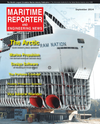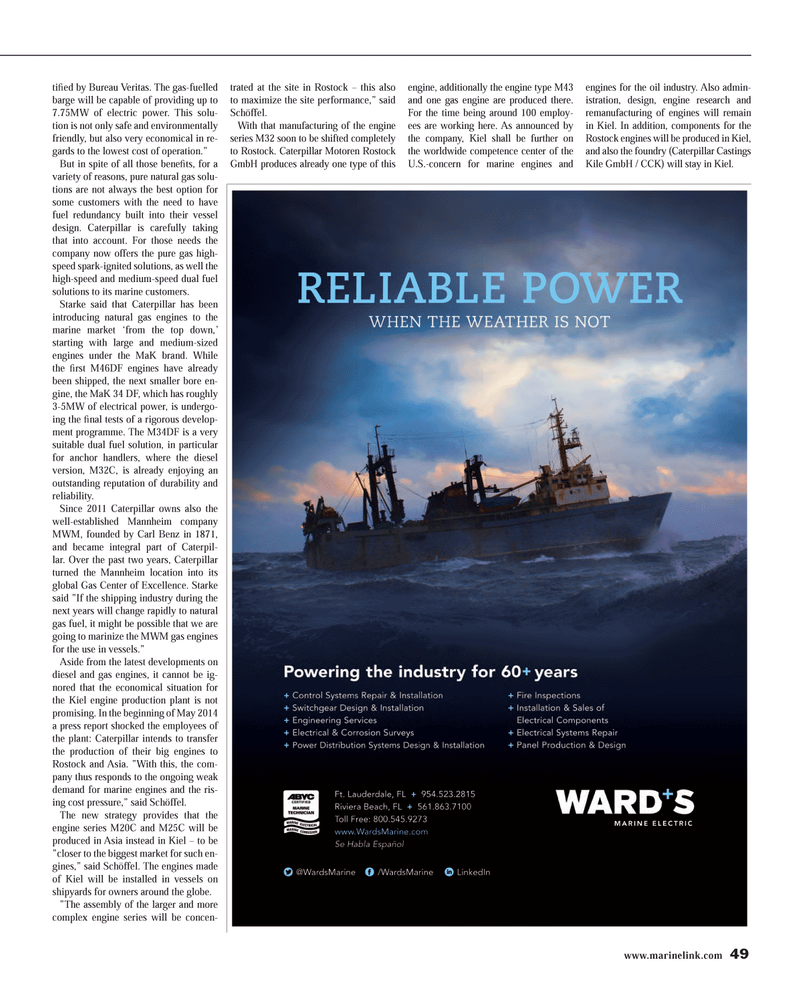
Page 49: of Maritime Reporter Magazine (September 2014)
Marine Propulsion Edition
Read this page in Pdf, Flash or Html5 edition of September 2014 Maritime Reporter Magazine
www.marinelink.com 49 tifi ed by Bureau Veritas. The gas-fuelled barge will be capable of providing up to 7.75MW of electric power. This solu- tion is not only safe and environmentally friendly, but also very economical in re- gards to the lowest cost of operation.”
But in spite of all those benefi ts, for a variety of reasons, pure natural gas solu- tions are not always the best option for some customers with the need to have fuel redundancy built into their vessel design. Caterpillar is carefully taking that into account. For those needs the company now offers the pure gas high- speed spark-ignited solutions, as well the high-speed and medium-speed dual fuel solutions to its marine customers.
Starke said that Caterpillar has been introducing natural gas engines to the marine market ‘from the top down,’ starting with large and medium-sized engines under the MaK brand. While the fi rst M46DF engines have already been shipped, the next smaller bore en- gine, the MaK 34 DF, which has roughly 3-5MW of electrical power, is undergo- ing the fi nal tests of a rigorous develop- ment programme. The M34DF is a very suitable dual fuel solution, in particular for anchor handlers, where the diesel version, M32C, is already enjoying an outstanding reputation of durability and reliability.
Since 2011 Caterpillar owns also the well-established Mannheim company
MWM, founded by Carl Benz in 1871, and became integral part of Caterpil- lar. Over the past two years, Caterpillar turned the Mannheim location into its global Gas Center of Excellence. Starke said ”If the shipping industry during the next years will change rapidly to natural gas fuel, it might be possible that we are going to marinize the MWM gas engines for the use in vessels.”
Aside from the latest developments on diesel and gas engines, it cannot be ig- nored that the economical situation for the Kiel engine production plant is not promising. In the beginning of May 2014 a press report shocked the employees of the plant: Caterpillar intends to transfer the production of their big engines to
Rostock and Asia. ”With this, the com- pany thus responds to the ongoing weak demand for marine engines and the ris- ing cost pressure,” said Schöffel.
The new strategy provides that the engine series M20C and M25C will be produced in Asia instead in Kiel – to be ”closer to the biggest market for such en- gines,” said Schöffel. The engines made of Kiel will be installed in vessels on shipyards for owners around the globe. ”The assembly of the larger and more complex engine series will be concen- trated at the site in Rostock – this also to maximize the site performance,” said
Schöffel.
With that manufacturing of the engine series M32 soon to be shifted completely to Rostock. Caterpillar Motoren Rostock
GmbH produces already one type of this engine, additionally the engine type M43 and one gas engine are produced there.
For the time being around 100 employ- ees are working here. As announced by the company, Kiel shall be further on the worldwide competence center of the
U.S.-concern for marine engines and engines for the oil industry. Also admin- istration, design, engine research and remanufacturing of engines will remain in Kiel. In addition, components for the
Rostock engines will be produced in Kiel, and also the foundry (Caterpillar Castings
Kile GmbH / CCK) will stay in Kiel.
MR #9 (40-49).indd 49 9/3/2014 2:06:09 PM

 48
48

 50
50
